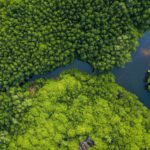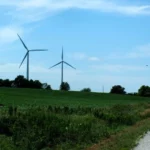Research shows that Indigenous communities in Canada are at higher risk from climate-related disasters such as flooding. Myrle Ballard is setting out to make sure Indigenous people are also part of the solution to climate change.

Ballard is the first director of Environment and Climate Change Canada’s new division of Indigenous Science, a role in which she’s tasked with raising awareness of Indigenous science within the department and helping the government find ways to integrate it into its policies.
“Indigenous science is … a science of the way of knowing the land. It’s a way of knowing the water, the air, everything about the Earth. Their knowledge of the weather patterns, their knowledge of how species migrate,” Ballard said in an interview with What On Earth. “It’s this knowledge that has enabled them to survive.”
Ballard, an assistant professor in the faculty of science at the University of Manitoba, is Anishinaabe from Lake St. Martin First Nation. Some of her own research looks at what Indigenous languages reveal about local ecosystems. She said her own first language, Anishinaabemowin, has a scientific management tool embedded within it.
“We have words for various spaces and places right across the country that are very significant to the natural state of the ecosystem,” she said.
The names of streams, for example, reveal details about the natural way water flows. Other words contain information about when fish start to spawn, said Ballard.
“We have words like that that are very significant as a biological monitor throughout our language,” said Ballard. “They’re the indicators of the state of the ecosystem and the way it was before, to the present.”
Ballard, who was hired in July to lead the new permanent division, is using a process she calls “bridging, braiding and weaving.” Bridging means raising awareness about Indigenous science within the government, while braiding is when Western scientists work together on research with Indigenous peoples on the land.
“The weaving process will be when the government, when the department ECCC, starts weaving Indigenous and Western science for better-informed decision-making,” she said.
This concept is not new for Dominique Henri, a wildlife researcher with the ministry. She’s been collaborating for about 15 years on research with Indigenous partners in the Arctic and subarctic. Most recently, she worked with Inuit partners to study the impact of climate change on polar bears.
“The bear biologists within our team learned tremendously from listening to elders’ stories and narratives,” she said. “It’s just been beautiful to see how it’s just different parts of a puzzle. [Western] science doesn’t know it all; Inuit don’t know it all, either. And by putting those pieces together, then you just have such a more rich, fuller picture of what’s going on.”
Henri said these partnerships aren’t easy to forge. It’s important to use a process that’s reciprocal, mutually beneficial and ethical, she said. And engaging properly with communities takes time. But Henri said having Ballard in this role will help.
“This team has a crucial role to play moving forward. And I hope that we can learn from this, and that other departments can then also create similar structures and that other initiatives can spread across the country,” she said.
“I think this is the future. This approach of mobilizing multiple ways of knowing in environmental conservation is really needed, I would say, to address the ecological crisis we are facing now.”
During her first few weeks in the role, Myrle Ballard has been organizing a speaker series, inviting government scientists to learn from Indigenous scholars and experts on environmental issues. A spokesperson from the department said via email that the series has so far had three speakers and more than 800 participants.
Ballard is confident the work is already making a difference.
“We’re creating change, I know we are, because we’re getting a lot of interest from within the government,” she said. “We’re not quite there yet, there’s a lot of work to be done, [but] we’ll get there eventually. It just takes time.”
Source: CBC











Add Comment